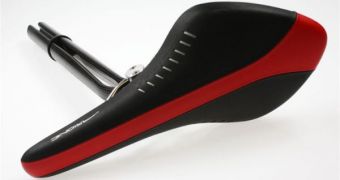German researchers at the Fraunhofer Gesellschaft argue that carbon fiber composite materials (CFRP) are not only the future of aircraft and automobile construction, but that they could also bring about a new boost as far as bicycle design goes. They will present their ideas, alongside with a spring-loaded seat post made of CFRP, in Stuttgart between October 27-29, at the Composites Europe trade show. These materials will play an important part in the industry of tomorrow, because they are very lightweight and resistant at the same time, which makes them apt for applications that take up a lot of resources at this point.
Curbstone edges, potholes, and streetcar tracks are roadside features that get on the nerves of any one and all bicyclists, and almost all of them would want these obstacles to go away. Spring-loaded seat posts appeared specifically to combat this discomfort, and they have evolved considerably over the years. The design that Fraunhofer Gesellschaft researchers propose is ultra light and extraordinarily effective at making the ride seem smoother, AlphaGalileo reports.
“A hardtail mountain bike with this new kind of CFRP seat post rides as if it were a full suspension bike,” triathlon world champion Daniel Unger said of the new seat post after a test drive. The innovation won the Eurobike Award this September, at the Eurobike 2009 trade show. It has also been nominated for the 2009 AVK Award for Innovation to take place in Stuttgart later this month.
“The impetus for this came from our colleague and bicycle enthusiast, Sergei Belaew. The component is based on two CFRP profiles that work like laminated springs. In this respect, the spring rigidity was calibrated to keep the deflection within the 10 to 15 millimeter range. That tangibly augments rider comfort,” Oliver Geiger, the group manager who handles the implementation of the new seat post in Professor Frank Henning's department at Fraunhofer, added. Essentially, “more ride comfort at 30 percent less weight,” he pointed out.
The manufacturing process, called Resin Transfer Molding (RTM), was fairly simple, Belaew pinpointed. “First, you fit the braided cable sleeves like a sock onto the mold core – a butyl sleeve – and stretch them until you get to the desired fiber angle. After pumping up the tubes as defined, a resin-hardening mixture infiltrates the component. As the hardening begins, the pressure on the butyl tubes is increased again, in order to achieve maximum impregnation,” he concluded.

 14 DAY TRIAL //
14 DAY TRIAL //